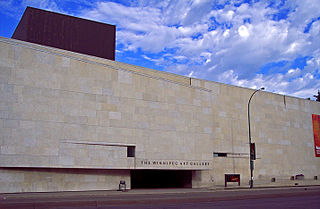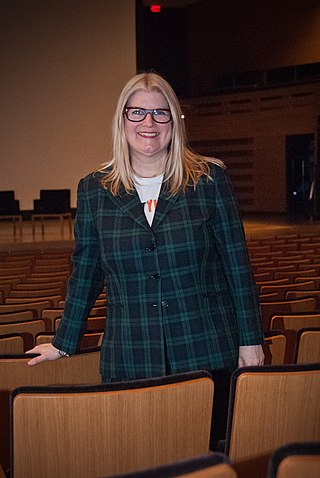
The Winnipeg Art Gallery (WAG) is an art museum in Winnipeg, Manitoba, Canada. Its permanent collection includes over 24,000 works from Canadian, Indigenous Canadian, and international artists. The museum also holds the world's largest collection of Inuit art. In addition to exhibits for its collection, the museum has organized and hosted a number of travelling arts exhibitions. Its building complex consists of a main building that includes 11,000 square metres (120,000 sq ft) of indoor space and the adjacent 3,700-square-metre (40,000 sq ft) Qaumajuq building.

Wanda Koop is a Canadian interdisciplinary artist who lives and works in Winnipeg, Manitoba. As well as being an artist, she is a community activist and founded Art City, a free community art centre for inner city youth in Winnipeg (1998).
Germaine Koh is a Malaysian-born and Canadian conceptual artist based in Vancouver. Her works incorporate the artistic styles of neo-conceptual art, minimalism, and environmental art, and is concerned with the significance of everyday actions, familiar objects and common places.

Annie Pootoogook was a Canadian Inuk artist known for her pen and coloured pencil drawings. In her art, Pootoogook often portrayed the experiences of those in her community of Kinngait, in northern Canada, and memories and events from her own life.
The Sobey Art Award is Canada's largest prize for young Canadian artists. It is named after Canadian businessperson and art collector Frank H. Sobey, who established The Sobey Art Foundation. It is an annual prize given to an artist 40 and under who has exhibited in a public or commercial art gallery within 18 months of being nominated. A jury consisting of an international juror and representatives of galleries from the West Coast and the Yukon, the Prairies and the North, Ontario, Quebec and the Atlantic Provinces creates a longlist of 25 artists, five from each region. The jury meets to select the winner and four other finalists, one from each region.
KC Adams is a Cree, Ojibway, and British artist and educator based in Winnipeg, Manitoba.
Ursula Johnson is a multidisciplinary Mi’kmaq artist based in Halifax, Nova Scotia, Canada. Her work combines the Mi’kmaq tradition of basket weaving with sculpture, installation, and performance art. In all its manifestations her work operates as didactic intervention, seeking to both confront and educate her viewers about issues of identity, colonial history, tradition, and cultural practice. In 2017, she won the Sobey Art Award.
Joi T. Arcand is a nehiyaw photo-based artist from Muskeg Lake Cree Nation, Saskatchewan, who currently resides in Ottawa, Ontario. In addition to art, Arcand focuses on publishing, art books, zines, collage and accessibility to art.
Lorna Brown is a Canadian artist, curator and writer. Her work focuses on public space, social phenomena such as boredom, and institutional structures and systems.
Aganetha Dyck is a Canadian sculptor residing in Winnipeg, Manitoba. Dyck is best known for her work with live honeybees, that build honeycomb on objects that she introduces to honeybee hives. In 2007 Dyck was awarded both Manitoba's Arts Award of Distinction and Canada's Governor General's Award in Visual and Media Arts.
Diana Thorneycroft is a Canadian artist based in Winnipeg, Manitoba, whose work has exhibited nationally and internationally. She works primarily in photography, drawing, and sculpture/installation and makes photographs of staged dioramas to explore sexuality and national identity, and even, national icons such as the Group of Seven. Her work blurs the lines between gendered bodies by employing phalluses. She is also an educator: she worked as a sessional instructor at the University of Manitoba's School of Art for 25 years.
Laiwan is a Zimbabwean interdisciplinary artist, art critic, gallerist, writer, curator and educator. Her wide-ranging practice is based in poetics and philosophy. She lives in Vancouver, British Columbia.

Jeneen Frei Njootli is an interdisciplinary Vuntut Gwitchin artist known primarily for their work with sound and textiles, performance, fashion, workshops, and barbeques.
Tanya Lukin Linklater is an artist-choreographer of Alutiiq descent. Her work consists of performance collaborations, videos, photographs, and installations.
Erica Eyres is a Canadian artist who lives and works in Glasgow.
Wanda Nanibush is an Anishinaabe curator, artist and educator based in Toronto, Ontario. From 2016 to 2023, she held the position of the inaugural curator of Indigenous Art at the Art Gallery of Ontario.
Maureen Gruben is a Canadian Inuvialuk artist who works in sculpture, installation and public art.
Anne Low is a multi-disciplinary artist based in Montreal, Canada. She uses sculpture, installation, textiles and printmaking to explore the relationship of historical contexts of contemporary functional objects and themes that occur, such as the domestic and the decorative. Her works highly focus on the physicality of an object and utilize her historic knowledge of weaving and various methodologies.
Asinnajaq, a.k.a.Isabella Rose Rowan-Weetaluktuk, is a Canadian Inuk visual artist, writer, filmmaker, and curator, from Inukjuak, Quebec. She is most noted for her 2017 film Three Thousand, which received a Canadian Screen Award nomination for Best Short Documentary Film at the 6th Canadian Screen Awards.
Raymond Boisjoly, is an Aboriginal artist of Haida and Québécois origin based in Vancouver, British Columbia, Canada. His practice combines technological processes together with discourse focused on cultural propriety, satire, and poetic texts of mystifying origins. Boisjoly recognizes, emulates, and adapts the ideas and processes of other artists. His artwork leads the viewer to consider or even focus our thinking on how we perceive and accept culture into our lives. He is an assistant professor at the school for the contemporary arts at Simon Fraser University.




